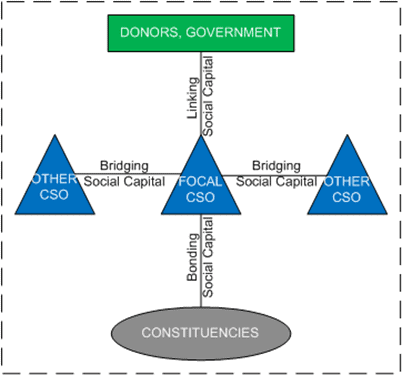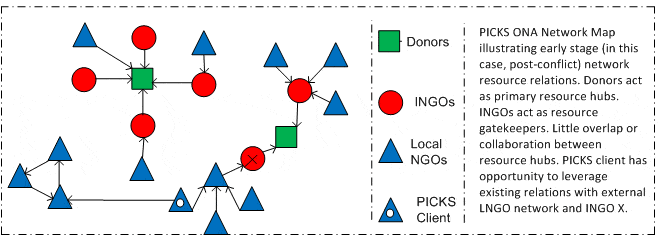Organizational development is typically associated with a capacity assessment and training to build an organization’s internal capacities. In the rush to develop OD projects, development practitioners tend to select the “strongest” or most cooperative LNGO partners in a particular region or network, form partnering agreements with them, and prescribe trainings to them. This has been the predominant management-focused approach for several decades, which we believe limits the potential for OD programming across the sector. Below are some steps, associated with LINC’s Organizational Network Analysis (ONA), that can make our collective OD approaches more strategic, selective, and systems-based:
Understand the role and types of social capital: Social capital-based network analysis enables program designers and implementers to examine an array of internal and external factors that influence an organization’s success and recognize them as actors in larger systems, designing and measuring the impact of programs that respond to specific social capital constraints. LINC’s Organizational Network Analysis (ONA) examines three forms of social capital (see Figure 1 below): First, bonding social capital looks at the extent to which organizations have been successful in understanding and responding to their communities or constituencies, oftentimes the very reason for their existence. Second, bridging social capital scores the extent to which organizations forge linkages and are central in broader peer networks, learn from each other and pool resources. Finally, linking capital examines the extent to which organizations engage with larger power structures, most often including government and donors that resource their work.

Figure 1: Illustration of bonding, bridging and linking social capital
Identify network opportunities and constraints: Conducting an organizational network analysis is much like analyzing a value chain. Relationships between actors are mapped-out, visually represented in a network map,, and opportunities and constraints are identified. Key bottlenecks and pathways are mapped to match with your program objectives. This may include targeting of specific CSOs, or groupings of them.

Design appropriately: Oftentimes, the largest CSOs have high internal management capacities, are close to donors (high linking social capital), but are distant from their constituents (low bonding social capital). Ask yourself, is this the right organization to engage for community-level impact? In other cases, we may find vibrant connections between key CSOs and their constituencies, but weak overall sharing and learning among network members. Ask yourself, should we focus resources directly on communities, or is it better to promote cross-CSO collaboration and resource hubs?
Measure rigorously: LINC’s ONA is conducted on an organization-by-organization basis, and applied to the larger networks in which they operate. A baseline is conducted at the design phase, with follow-up mid-term and final evaluation undertaken at the conclusion of the program. Given sufficient sample power, quasi-experimental findings can be generated and applied to both the organizations surveyed and network as a whole. Read more about LINC’s ONA module.
